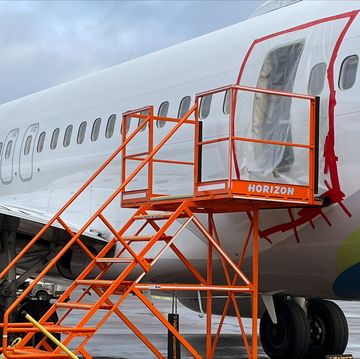- Rigid airships were largely abandoned after the Hindenburg's 1937 crash and an increased military preference for planes. But they could make a comeback as cargo vessels.
- Rigid airships could potentially use far less carbon dioxide than boats. And a solar-powered airship could use jet streams to fly across the globe in record time.
- But there's the challenge of efficiency. Any potential rigid airship built to handle the world's supplies would have to be the largest rigid airship ever built.
While it would be inaccurate to say that rigid airships have been relegated to history, few methods of transportation have ever faced such a setback based on a single incident. When LZ 129 Hindenburg crashed in 1937, it took a whole industry down with it. But scientists are now considering bringing Zeppelins back as cargo containers.
On May 6, 1937, the Hindenburg crash killed 36 people in a particularly horrifying manner as it burst into flames in Manchester Township, New Jersey, punctuated by announcer Herb Morrison's live commentary of, "Oh, the humanity!"
The fire couldn't have come at a worse time for DZR, the German company that owned and operated the Zeppelin-class airship. Tensions with its home country, Germany, were rising in the West, technological trends were heading toward heavier-than-air planes, and DZR scrapped its metal in 1940. While there have been sporadic attempts to revive the industry, they've emerged as a niche at best.
A new study, from scientists at the International Institute of Applied Systems Analysis (IIASA), Laxenburg, Austria and published in the Energy Conversion and Management, doesn't try to revive the glamour of transatlantic voyages. Instead, the scientists focus on the less-exciting, but more crucial, industry of cargo transportation. Airships could play a role in fighting global warming, they say.
"The maritime shipping sector is a major contributor to CO2 emissions and this figure is expected to rise in coming decades," reads the paper's abstract. This is backed up by statistics. Around a quarter (23 percent) of the world's carbon dioxide emissions stem from transportation. In the U.S., it's higher, at 29 percent. At home and abroad, boats represent around 3 percent of transportation emissions.
"With the intent of reducing emissions from this sector, this research proposes the utilization of the jet stream to transport a combination of cargo and hydrogen, using airships or balloons at altitudes of 10—20 km(6.2—12.4 miles)," the study says.
Jet streams are meandering air currents within the Earth's atmosphere that move all across the planet. While their meandering nature means they go in all directions, scientists track them reliably. Catching one would give a rigid airship an extra boost.
"The jet streams flow in the mid-latitudes predominantly in a west–east direction, reaching an average wind speed of 165 km/h (102 MPH)," says the study. "Using this combination of high wind speeds and reliable direction, hydrogen-filled airships or balloons could carry hydrogen with a lower fuel requirement and shorter travel time compared to conventional shipping."
Thanks to the advent of new materials, airships have been considered around the globe for everything from broadband expansion to delivering humanitarian aid. And there's also been substantial research on solar-power based airships, considering that they could fly above the clouds.
Looking at the possibilities, the researchers focused on a 2016 expedition by Russian adventurer Fedor Konyukhov, who broke the record for the fastest around-the-world flight in a hot air balloon. Forget 80 days—Konyukhov used jet streams to circumnavigate the globe in just 11 days. The same principles apply to the airships.
Zeppelins like the Hindenburg were the largest rigid airships ever built. Amazingly, they still are. Size presents a challenge to the modern cargo rigid airship.
"The envelope area and hydrogen or helium gas volume ratio reduce considerably with the increase in airship dimensions," the study authors write. "For example, while a tenfold increase in the diameter and length of the airship will increase the hydrogen volume stored and its useful lift a thousand-fold, it will only increase the envelope material by a factor of 100. This means that the cost of the envelope of the airship reduces tenfold."
For the hypothetical rigid airship to be as effective as cargo boats are today, it would have to be over five times as long as the Empire State Building is tall. Beyond the logistics of building the thing, the docking of the airship would be a challenge due to limited control mechanisms, and strong winds could make it collapse.
But if these challenges could be overcome, the scientists say, a fleet of 1,125 rigid airship carriers "would be able to transport energy equivalent to 10 [percent] of current world electricity consumption." Despite the obstacles, the fleet could be a support structure for the globe as it transitions to cleaner energy.
David Grossman is a staff writer for PopularMechanics.com. He's previously written for The Verge, Rolling Stone, The New Republic and several other publications. He's based out of Brooklyn.













